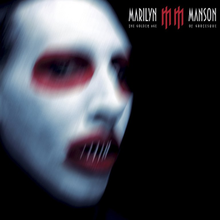Vodevil
| The Golden Age of Grotesque | ||||
|---|---|---|---|---|
 |
||||
| Studio album by Marilyn Manson | ||||
| Released | May 7, 2003 | |||
| Recorded | 2002–03 | |||
| Studio |
|
|||
| Genre | ||||
| Length | 57:32 | |||
| Label | ||||
| Producer |
|
|||
| Marilyn Manson chronology | ||||
|
||||
| Singles from The Golden Age of Grotesque | ||||
|
||||
| Professional ratings | |
|---|---|
| Aggregate scores | |
| Source | Rating |
| Metacritic | 60/100 |
| Review scores | |
| Source | Rating |
| AllMusic | |
| Alternative Press | |
| Drowned in Sound | 7/10 |
| E! Online | B |
| Entertainment Weekly | B− |
| The Guardian | |
| Mojo | |
| PopMatters | 3/10 |
| Q | |
| Rolling Stone | |
The Golden Age of Grotesque is the fifth studio album by American rock band Marilyn Manson. It was released on May 7, 2003 by Nothing and Interscope Records, and was their first album to feature former KMFDM member Tim Sköld, who joined after longtime bassist Twiggy Ramirez amicably left the group over creative differences. It was also their final studio album to feature keyboardist Madonna Wayne Gacy and guitarist John 5, who would both acrimoniously quit before the release of the band's next studio album.
The record was produced by Marilyn Manson and Sköld, with co-production from Ben Grosse. Musically, it is less metallic as the band's earlier work, instead being more electronic and beat-driven. This was done to avoid creating music similar to nu metal, a then-predominant genre of hard rock which the vocalist considered cliché. Manson collaborated with artist Gottfried Helnwein to create several projects associated with the album, including Doppelherz, a 25-minute surrealist short film which was released on limited edition units of the record as a bonus DVD. The Golden Age of Grotesque was also the title of the Manson's first art exhibition.
The album's lyrical content is relatively straightforward, and was inspired by the swing, burlesque, cabaret and vaudeville movements of Germany's Weimar Republic-era, specifically 1920s Berlin. In an extended metaphor, Manson compares his own work to the Entartete Kunst banned by the Nazi regime as he attempts to examine the mindset of lunatics and children during times of crisis. Several songs incorporate elements commonly found in playground chants and nursery rhymes. "Mobscene" (stylized as "mOBSCENE") and "This Is the New Shit" were released as singles, and a controversial music video was released for "Saint" (stylized as "(s)AINT").
...
Wikipedia
